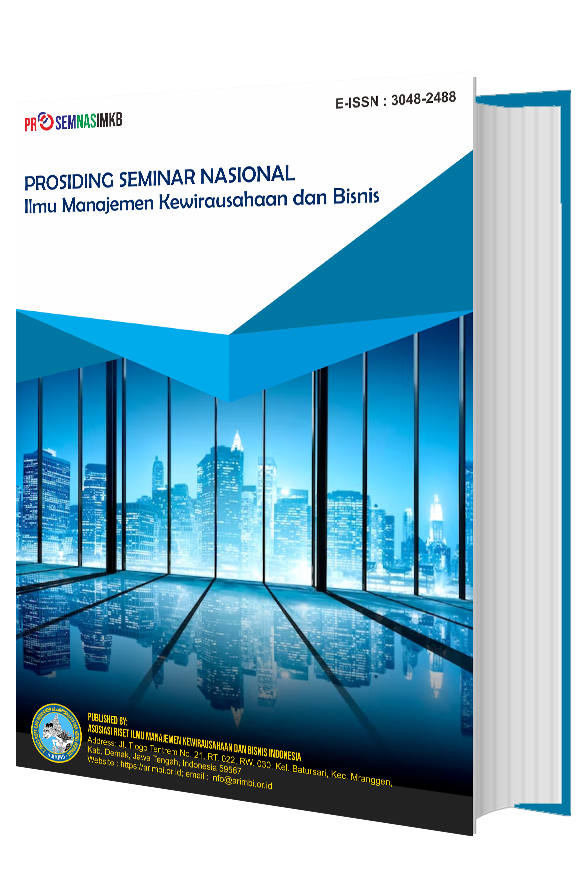Optimalisasi Potensi Alam, Ekonomi, dan Budaya Desa Wisata Pupus melalui Pendekatan Green Digital Management
DOI:
https://doi.org/10.61132/prosemnasimkb.v2i2.194Keywords:
Creative economy, Cultural heritage, Green Digital Management, Natural potential, Pupus Tourism VillageAbstract
Pupus Tourism Village in Ponorogo Regency is a pioneering tourist village endowed with diverse natural, economic, and cultural potential, yet its development remains constrained by limited infrastructure and insufficient utilization of digital technology. This condition has hindered the optimization of local attractions such as Mloko Sewu, Selorejo Waterfall, Mount Tapak Bimo trekking, as well as local products including palm sugar, coffee, porang, and goat milk in supporting the village economy. This study aims to analyze strategies for optimizing village potential through the application of Green Digital Management (GDM) as an effort to establish sustainable tourism business practices. A qualitative research approach was employed, with data collected through observation, interviews, and documentation. The findings reveal that the implementation of GDM can serve as a strategic approach for Pupus Tourism Village by integrating environmentally based digital promotion, strengthening eco-friendly creative economy initiatives, and revitalizing local culture such as the bersih desa ritual and communal work (gotong royong). The implications highlight the importance of collaboration between government, community, and tourism stakeholders in applying GDM to enhance the competitiveness of Pupus Tourism Village while simultaneously promoting sustainable economic, social, and ecological development.
Downloads
References
Abreu, L. A., et al. (2024). Community-based tourism and best practices with the sustainable development goals. Journal of Business, 14(2), 45–62. https://doi.org/10.3390/admsci14020036
Anonymous. (2024). Digitalization and digital transformation in the tourism industry: A bibliometric review. ResearchGate.
Barney, J. (1991). Firm resources and sustained competitive advantage. Journal of Management, 17(1), 99–120. https://doi.org/10.1177/014920639101700108
Bhandari, K. R., Ranta, M., & Salo, J. (2022). The resource-based view, stakeholder capitalism, ESG, and sustainable competitive advantage: The firm’s embeddedness into ecology, society, and governance. Business Strategy and the Environment, 31(4), 1525–1537. https://doi.org/10.1002/bse.2967
Buhalis, D., & Amaranggana, A. (2015). Smart tourism destinations: Enhancing tourism experience through personalization of services. In I. Tussyadiah & A. Inversini (Eds.), Information and Communication Technologies in Tourism 2015 (pp. 377–389). Springer. https://doi.org/10.1007/978-3-319-14343-9_28
Butler, R. W. (1980). The concept of a tourist area cycle of evolution: Implications for management of resources. The Canadian Geographer, 24(1), 5–12. https://doi.org/10.1111/j.1541-0064.1980.tb00970.x
Butler, R. W. (1999). Sustainable tourism: A state-of-the-art review. Tourism Geographies, 1(1), 7–25. https://doi.org/10.1080/14616689908721291
Creswell, J. W. (2014). Research design: Qualitative, quantitative, and mixed methods approaches (4th ed.). Sage.
Dangi, T. B., & Jamal, T. (2016). An integrated approach to sustainable community-based tourism. Sustainability, 8(5), 475. https://doi.org/10.3390/su8050475
Denzin, N. K., & Lincoln, Y. S. (2018). The Sage handbook of qualitative research (5th ed.). Sage.
Dote-Pardo, J., & Ceballos-Garrido, P. (2024). Trends and research lines on triple bottom line: A bibliometric analysis of the management and business ambit. Russian Law Journal, 12(2).
Elia, S., Margherita, A., & Passiante, G. (2021). Resources and digital export: An RBV perspective on the drivers of internationalization via digital channels. Journal of Business Research.
Elkington, J. (1994). Towards the sustainable corporation: Win-win-win business strategies for sustainable development. California Management Review, 36(2), 90–100. https://doi.org/10.2307/41165746
Elkington, J. (2020). Green swans: The coming boom in regenerative capitalism. Fast Company Press.
Gretzel, U., Sigala, M., Xiang, Z., & Koo, C. (2015). Smart tourism: Foundations and developments. Electronic Markets, 25(3), 179–188. https://doi.org/10.1007/s12525-015-0196-8
Gretzel, U., Sigala, M., Xiang, Z., & Koo, C. (2020). Smart tourism: Foundations and developments. Electronic Markets, 30(1), 1–10.
Hall, C. M. (2020). Constructing sustainable tourism development: The 2030 agenda and the managerial ecology of sustainable tourism. Journal of Sustainable Tourism, 28(10), 1424–1440. https://doi.org/10.4324/9781003140542-12
Helfat, C. E., Kaul, A., Ketchen, D. J., Barney, J. B., Chatain, O., & Singh, H. (2023). Renewing the resource-based view: New contexts, new concepts, and new methods. Strategic Management Journal, 44(6), 1357–1390. https://doi.org/10.1002/smj.3500
Hu, C. (2023). Achieving green tourism through environmental sustainability and digital technologies. Journal of Cleaner Production, 412, 137–148.
Kero, C. A., & Bogale, A. T. (2023). A systematic review of resource-based view and dynamic capabilities of firms and future research avenues. International Journal of Sustainable Development and Planning, 18(10), 2795–2807. https://doi.org/10.18280/ijsdp.181016
Kvale, S., & Brinkmann, S. (2009). InterViews: Learning the craft of qualitative research interviewing (2nd ed.). Sage.
Liang, D. (2024). The impact of digital transformation on enterprise development: An RBV perspective. Sustainability.
Lim, W. M., Yap, S. F., & Makkar, M. (2021). Adopting digital technologies for sustainable business practices: A systematic review. Journal of Business Research, 128, 255–268.
Melville, N. P. (2010). Information systems innovation for environmental sustainability. MIS Quarterly, 34(1), 1–21. https://doi.org/10.2307/20721412
Miles, M. B., Huberman, A. M., & Saldaña, J. (2014). Qualitative data analysis: A methods sourcebook (3rd ed.). Sage.
Murphy, P. E. (1985). Tourism: A community approach. Routledge.
Naharuddin, N. S., Abdul Rahim, R., & Ngah, R. (2024). Determinants impacting the triple bottom line sustainability performance in SMEs: A systematic literature analysis and future research agenda. Advances in Social Sciences Research Journal, 11(2.2), 66–77. https://doi.org/10.14738/assrj.112.2.16401
Nogueira, E., Gomes, S., & Lopes, J. M. (2025). Unveiling triple bottom line’s influence on business performance. Discover Sustainability, 6, Article 43. https://doi.org/10.1007/s43621-025-00804-x
Nuryanti, W. (1993). Concept, perspective and challenges of rural tourism. Gadjah Mada University Press.
OECD. (2023). Inclusive, green and digital transformation. OECD Publishing.
Patton, M. Q. (2015). Qualitative research & evaluation methods (4th ed.). Sage.
Purwoko, Y., Wigati, E., Pradapa, S. Y. F., Noviastuti, N., Hakim, M. F. N., & Kustini, H. (2023). Development of village potential into a tourism village in Nglegi Gunungkidul Village. Media Wisata, 21(2), 240–249. https://doi.org/10.36276/mws.v21i2.491
Rahmawati, D., & Hidayat, T. (2022). Community-based conservation in the development of sustainable tourism village. Tourism and Hospitality Management Journal, 28(2), 233–245.
Reuters. (2025). How travel is getting smart, and more sustainable, with AI. Reuters.
Spradley, J. P. (2016). Participant observation. Waveland Press.
Timothy, D. J. (2021). Cultural heritage and tourism: An introduction. Channel View Publications.
Tri, & Erna. (2020). Langkah-langkah strategis pengembangan desa wisata. Indonesiana.
Tri Wahyuningsih, & Wigati, E. (2021). Pengembangan desa wisata berbasis community based tourism (CBT): Desa wisata Sumberbulu, Desa Pendem, Mojogedang, Karanganyar. CV. Pena Persada.
Tundys, B., & Wiśniewski, T. (2023). Triple bottom line aspects and sustainable supply chain resilience: A structural equation modelling approach. Frontiers in Environmental Science, 11, 1161437. https://doi.org/10.3389/fenvs.2023.1161437
UNWTO. (2020a). Sustainable development / Digital transformation in tourism. UNWTO.
UNWTO. (2020b). Tourism and the sustainable development goals: A guidebook. UNWTO.
Wibbens, P. D. (2023). A formal framework for the RBV: Resource dynamics as a Markov process. Strategic Management Journal, 44(6), 1562–1586. https://doi.org/10.1002/smj.3339
Wigati, E., & Indriastuti, W. A. (2021). Sustainable tourism: Deswita berkembang menjadi deswita maju di Desa Wisata Sumberbulu. Media Wisata, 19(2), 255–258. https://doi.org/10.36276/mws.v19i2.131
Wigati, E., & Kuswiyata, P. (2022). Role of Pokdarwis in assistance of tourism village community empowerment in Dongde Valley. Media Wisata, 20(2), 162–170. https://doi.org/10.36276/mws.v20i2.335
Wigati, E., Purwoko, Y., & Murti, A. (2023). Pengelolaan deswita rintisan Dewi Pandang berbasis CBT di Desa Pandanpuro, Pakem, Sleman. Jurnal Pariwisata, 10(2), 123–138. https://doi.org/10.31294/par.v10i2.17420
Wigati, E., Winarno, S. B., Sugiama, A. G., & Kustini, H. (2025). Management strategies for homestays in Pancoh Tourism Village, Turi, Sleman. Media Wisata, 23(1), 231–244. https://doi.org/10.36276/mws.v23i1.754
Wijayanti, A., Prabowo, R., & Sari, D. P. (2023). Digital branding strategy for local culture in sustainable tourism village development. Journal of Tourism Development, 11(1), 77–91.
Yin, R. K. (2018). Case study research and applications: Design and methods (6th ed.). Sage.
Downloads
Published
How to Cite
Issue
Section
License
Copyright (c) 2025 Prosiding Seminar Nasional Ilmu Manajemen Kewirausahaan dan Bisnis

This work is licensed under a Creative Commons Attribution-ShareAlike 4.0 International License.






